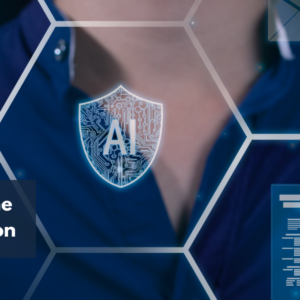This is the fifth blog post for NanoMatriX’s AI Governance Series.
Artificial intelligence is no longer a futuristic concept. It has become a vital part of our daily lives and business operations. The market for AI grew beyond 184 billion U.S. dollars in 2024. This staggering growth is expected to continue, with the market racing past 826 billion U.S. dollars in 2030. This rapid growth shows the increasing reliance on AI technologies across various sectors.
WeForum mentions that by 2025, as many as 97 million people will work in the AI space, highlighting its widespread adoption. Furthermore, AI is expected to contribute an astonishing $25.6 trillion to the global economy by 2030. As businesses seek to enhance efficiency and drive innovation, developing effective AI management systems becomes important. These systems help companies deal with the complexities of AI implementation and make sure that they can harness their full potential while addressing challenges related to ethics and governance.
Let’s explore how to develop an AI management system, its key components, and the steps to create one.
Key Components of an AI Management System
Building an effective AI management system starts with understanding its core components. These are the key areas that need attention:
1. Governance Framework
Governance ensures that AI systems are used responsibly and ethically. It helps organizations follow rules, reduce risks, and stay aligned with global standards like ISO 42001 or the NIST AI Risk Management Framework. A clear governance plan ensures that AI tools are both fair and transparent.
2. Data Management
Data is the foundation of any AI system. Poor-quality data leads to poor results. A good AI management system ensures data is clean, accurate, and secure. It also focuses on proper data labeling and storage, ensuring the AI models are trained effectively.
3. Risk Management
AI systems can bring risks like bias, errors, or even security threats. Risk management focuses on identifying these issues early and fixing them. This includes regular checks for bias, tracking model performance, and preparing solutions for unexpected problems.
4. Monitoring and Evaluation
AI systems need to be monitored to ensure they perform as expected. A good system measures success using clear performance metrics. It also allows organizations to make improvements over time and adjust systems when needed. Real-time monitoring tools are handy for catching issues before they become bigger problems.
By focusing on these components, businesses can create AI systems that are reliable, secure, and aligned with their goals.
Challenges in AI Management System Development
While building an AI management system can bring many benefits, there are some challenges businesses need to address.
- Cost and Resources: Developing a robust system requires investment in tools, technology, and skilled professionals. 53% of businesses state that high implementation costs are a major barrier to adopting AI solutions. Small businesses may struggle to allocate the budget needed for advanced solutions or expert teams.
- Scalability: As businesses grow, their AI systems need to handle larger amounts of data and more complex tasks. Designing a system that scales efficiently can be difficult, especially when future needs are uncertain. Due to technical and operational hurdles, Vorecol found that 70% of organizations struggle with scaling their AI systems beyond pilot projects.
- Regulatory Compliance: AI regulations are constantly evolving across different regions. Keeping up with these rules and ensuring compliance can be time-consuming. Non-compliance can lead to fines or damage to a company’s reputation. For instance, non-compliance with GDPR has resulted in fines totaling over €5 billion since its enforcement.
- Data Privacy and Security: Managing data securely is one of the biggest concerns in AI development. Research by IBM mentions that the average cost of a data breach in 2024 was $4.88 million. Protecting sensitive information while following privacy laws like GDPR can be a complex task.
- Cross-Departmental Collaboration: AI systems often involve multiple teams, such as IT, legal, and operations. Ensuring everyone works together smoothly can be challenging. Miscommunication or lack of coordination can slow down progress. 60% of executives believe misaligned priorities between departments slow down AI implementation.
Steps to Develop an Effective AI Management System
Creating an effective AI management system involves several important steps. These steps can help organizations build a strong foundation for their AI projects.
1. Define Objectives and Scope
The first step is clearly defining what you want to achieve with your AI system. Identify the specific problems you want to solve or the goals you want to reach. Setting clear objectives helps guide the entire development process. It also ensures that everyone in the organization understands the purpose of the AI project.
2. Data Strategy Development
Data is crucial for any AI system. Develop a strategy for collecting, storing, and managing data. Ensure you have access to high-quality data relevant to your objectives. It’s also important to consider data privacy and security. Make sure your data practices comply with regulations and protect sensitive information.
3. Choosing the Right Tools and Technologies
The right tools and technologies are essential for building an effective AI management system. Research various software and frameworks that can support your AI development needs. Consider factors such as ease of use, scalability, and compatibility with existing systems. Choosing the right tools can make the development process smoother.
4. Implementation and Testing
Once you have your data and tools, it’s time to implement your AI system. Start by developing your models based on the defined objectives. After implementation, conduct thorough testing to ensure that the system works as intended. Testing helps identify any issues early on, allowing for adjustments before full deployment.
5. Monitoring and Maintenance
After deploying your AI management system, ongoing monitoring is crucial. Regularly check the system’s performance to ensure it meets your objectives. Be prepared to make updates and improvements as needed. This includes retraining models with new data or adjusting processes based on feedback.
Role of Technology and Tools
Technology and tools are vital in building and managing an AI Management System. They simplify complex tasks and ensure the system works effectively.
- Streamlining Governance: AI governance tools help organizations follow ethical guidelines and regulatory standards. They automate processes like risk assessments, documentation, and compliance checks, saving time and reducing errors.
- Data Management Solutions: Tools for data management ensure the data used by AI is clean, secure, and compliant. These tools help organize, process, and store data efficiently while meeting privacy regulations like GDPR.
- Performance Monitoring Platforms: AI performance monitoring tools track how well your AI systems work. They analyze metrics like accuracy, speed, and system reliability. Early detection of issues prevents bigger problems down the line.
- Customizable Solutions: Every organization has unique needs, and customizable tools allow businesses to tailor AI Management Systems to their goals. For example, NanoMatriX offers solutions for different industries and compliance requirements.
- Scalability and Automation: Modern tools can scale as your AI needs to grow. Automation features in these tools reduce manual work, improve efficiency, and allow teams to focus on strategic tasks.
Why Choose NanoMatriX for AI Management System Development?
NanoMatriX stands out as a trusted partner for businesses looking to develop and manage AI systems effectively. Here is how NanoMatriX can help:
Tailored Solutions
NanoMatriX offers customized AI management systems designed to meet the specific needs of your business. Whether you are focusing on compliance, risk management, or scalability, their solutions can be adapted to your goals.
Expertise in AI Governance
With a deep understanding of frameworks like ISO 42001 and the NIST AI Risk Management Framework, NanoMatriX ensures your AI system is aligned with global standards. This helps businesses avoid risks and maintain ethical AI practices.
Advanced Tools for Monitoring
NanoMatriX provides advanced tools to monitor AI performance in real time. These tools help detect errors, measure success, and make improvements quickly, ensuring your system remains reliable and efficient.
Focus on Data Security
NanoMatriX places a strong emphasis on data privacy and protection. Their solutions are built to safeguard sensitive information and comply with data protection laws like GDPR.
Proven Track Record
NanoMatriX has a history of delivering high-quality solutions across industries. Businesses trust their expertise to create AI systems that drive results while staying secure and compliant.
Partnering with NanoMatriX ensures that your AI management system is robust efficient and future-ready to meet the growing demands of AI-driven innovation.
Ready to Build Your AI Management System?
Ready to develop a robust AI Management System that aligns with your goals and meets regulatory requirements? Our Developing an AI Management System course provides you with the knowledge and tools needed to govern, monitor, and optimize your AI solutions effectively.
With this course, you will:
- Gain a deeper understanding of AI governance frameworks and best practices.
- Learn how to integrate and manage data securely and efficiently.
- Master performance monitoring and risk mitigation strategies.’
- Discover how to ensure compliance with AI regulations and standards.
With expert instructors, real-world case studies, and hands-on exercises, you’ll learn how to design and maintain AI systems that drive success while staying aligned with global standards.
Take control of your AI systems and stay ahead in the rapidly evolving field of AI management. Enroll in NanoMatriX’s AI Management System course today and start building the skills that will power your business’s AI success for years to come.
Read the sixth blog post for NanoMatriX’s AI Governance Series here.
About NanoMatriX Technologies Limited
NanoMatriX is a specialist in providing document and brand protection solutions. To solve our customer’s problems, we provide the following product and service categories:
- Brand-/document protection platforms
- Custom Software development
- Cybersecurity services
- Anti-counterfeiting products
- Consulting services
The competitive advantages of NanoMatriX are:
- Two decades of experience helping brand owners and government agencies fight product and document crime worldwide.
- A unique combination of rare-to-find skills in linking physical overt, covert, and forensic security features with secure digital features.
- Proven rigorous application of top cyber security and data privacy protection standards.
- Multi-lingual, multi-cultural, and collaborative corporate culture.
NanoMatriX Technologies Limited is committed to the highest cyber security standards, data privacy protection, and quality management. Our systems are certified and compliant with leading international standards, including:
- ISO 27001: Ensuring robust Information Security Management Systems (ISMS).
- ISO 27701: Upholding Privacy Information Management Systems (PIMS) for effective data privacy.
- ISO 27017: Implementing ISMS for cloud-hosted systems, ensuring cybersecurity in cloud environments.
- ISO 27018: Adhering to PIMS for cloud-hosted systems, emphasizing privacy in cloud-hosted services.
- ISO 9001: Demonstrating our commitment to Quality Management Systems and delivering high-quality solutions.

















Recent Comments